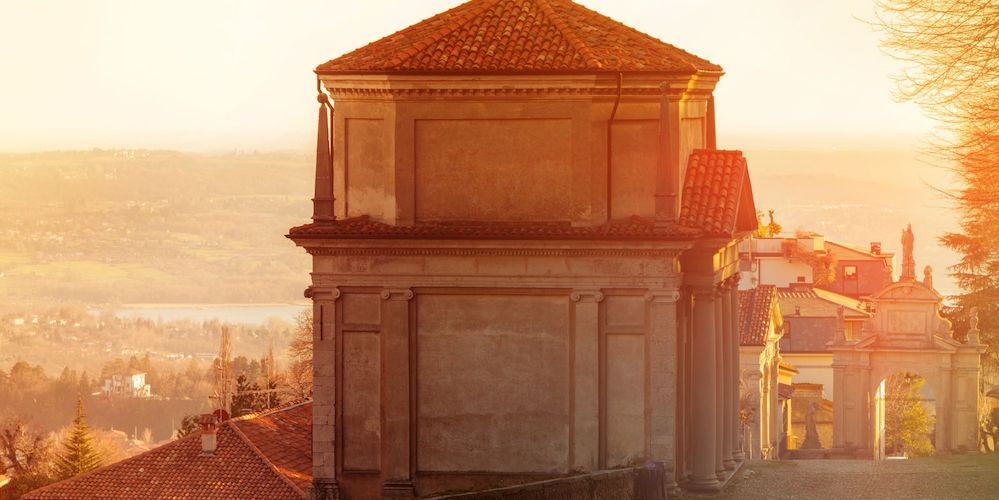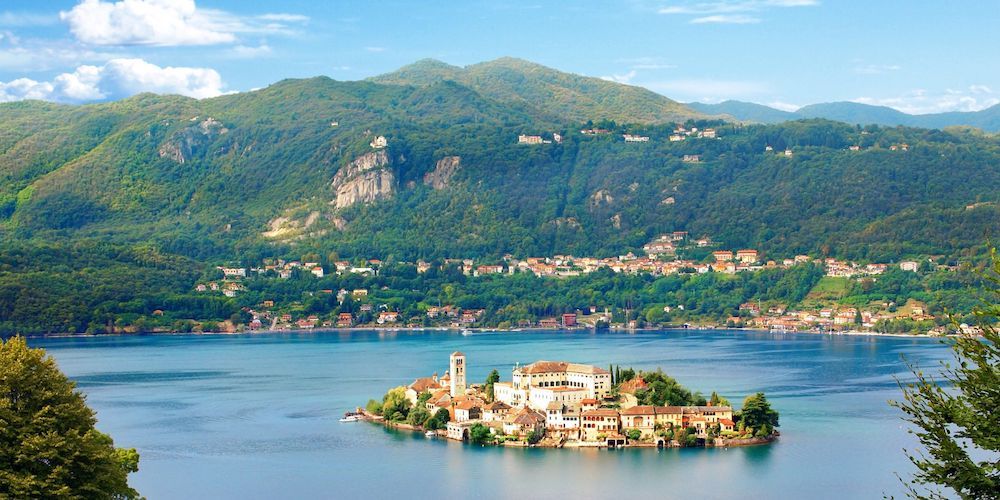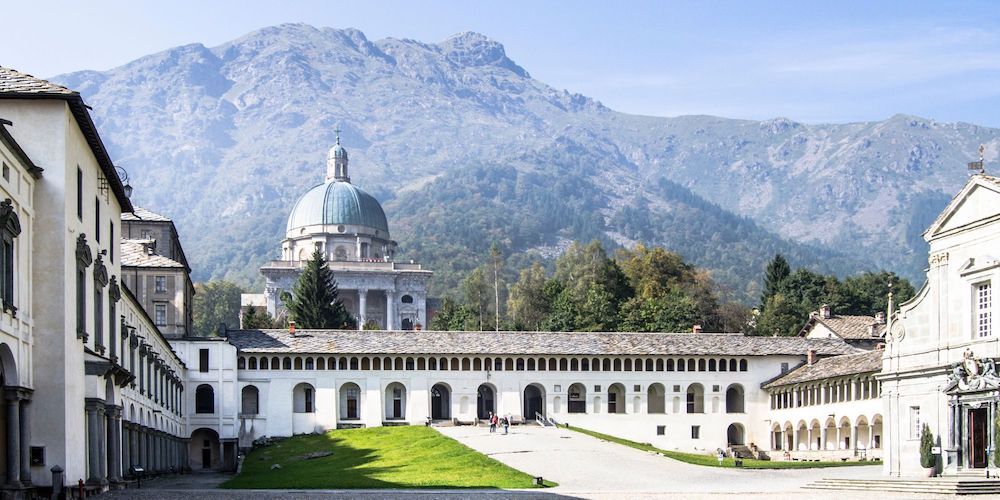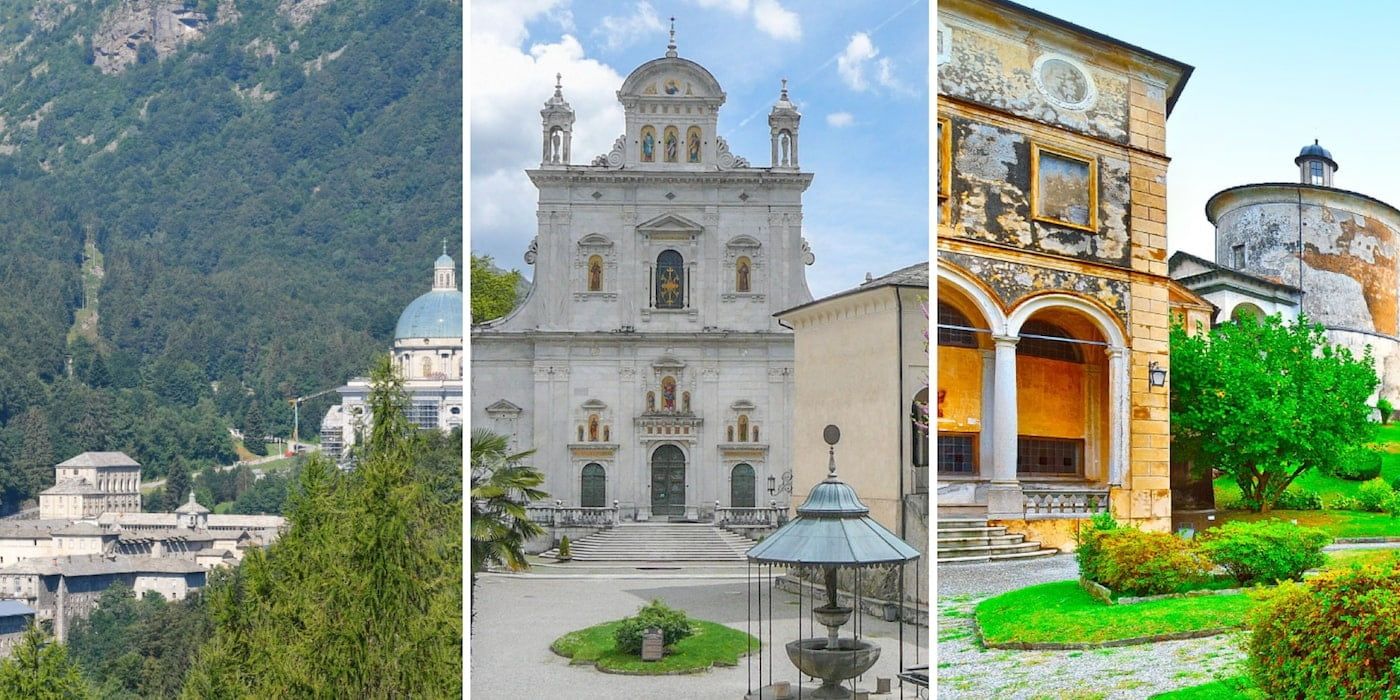Nature, sacred art and spirituality are the main features of a journey through the nine Sacri Monti of Piedmont and Lombardy, established from the 15th century as religious sites alternative to the traditional (but distant) territories of the Holy Land.
Here are nine itineraries by which we’ll discover both the historical role and the mystical side of these extraordinary complexes, which have been on the UNESCO World Heritage List since 2003.
Our route will start from the Sacri Monti of Piedmont (Varallo, the first to be established in 1480; Domodossola; Ghiffa; Orta; Oropa; Belmonte; Crea), to finally arrive at the sanctuaries of Ossuccio and Varese, in Lombardy.

The Sacri Monti as stages of a spiritual journey

Mountains, lakes and picturesque landscapes; but also monuments and chapels rich in art and history. The Sacri Monti of Piedmont and Lombardy attract tens of thousands of visitors every year, captured by the cultural attractions and the scenic beauty of these territories.
There is no doubt, however, that the mystical and spiritual component that emanates from each of the nine architectural complexes plays a fundamental role in the experience of visiting the Sacri Monti. In each of them, we find a series of shrines and religious structures in which we can admire statues or paintings that tell different scenes related to Christian history, for example about the life of Jesus, Mary or the Saints.
Each Sacred Mount, therefore, represents a sort of “pastoral via crucis", a way used over the centuries by the ecclesiastical authorities to communicate with the faithful, telling them the most evocative stories from a religious point of view to increase the popular faith.
Also for this reason, although starting from a common structure (various buildings built in strategic positions, on top of hills or mountains overlooking the surrounding territory), each of the nine complexes has developed unique artistic and architectural features.
That’s why the visit through the Sacri Monti of Piedmont and Lombardy represents a real spiritual journey that we will travel together stage after stage. Starting from the Sacro Monte di Varallo, in Piedmont.
Discover 10 unmissable UNESCO World Heritage Sites in ItalyVarallo, the first of the Sacri Monti of Piedmont and Lombardy

In the province of Vercelli, lying at the confluence of the Mastallone creek and the river Sesia, it’s located the small town of Varallo. From the banks of the river, we can look at the silhouette of the Sacro Monte, overlooking the town for over 500 years.
Here, in the heart of Piedmont, the Franciscan friar Bernardino Caimi imagined a transposition of the Holy Land. Thus, almost at the end of the 15th century, a series of buildings were built to reproduce the most iconic religious sites of Jerusalem.
These constructions were developed over the centuries and filled with artworks related to the universe of spirituality, giving life to a moral path made by paintings and sculptures that reproduce scenes of real life regarding the history of Christ, or about different events taken from the Bible and the Gospels.
Chapel 1, for example, offers statues and decorations of the late sixteenth century that tell the story of Adam and Eve and original sin (some statues of animals date back to the late nineteenth century); the chapels 2, 3 and 4 make up the so-called Nazareth complex, and describe the events of the Annunciation, the Visitation and the first dream of Joseph.
And so on, through the Bethlehem Complex, the Pilate Palace and the Calvary Complex, following a path that has a total of 45 chapels and that winds along a small and elegant grove.
A picturesque way to reach the heart of the complex, starting from Varallo, is by using the spectacular cable car (indicated as the steepest in Europe!) that connects the country to the area of the Sacro Monte. Or we can simply choose to pass through the monumental entrance after walking up the pedestrian path, just like the pilgrims of the past.
Sacro Monte of Domodossola

The Sacro Monte Calvario of Domodossola is located in the northern part of Piedmont, a few kilometers away from the border with Switzerland. The complex is surrounded by mountains and positioned above the slope of the Mattarella hill, towering over Domodossola and the Toce river and offering a spectacular view over the Ossola Valley.
Compared to that of Varallo, this Sacro Monte appears smaller and more spartan. We can understand the reason by taking a look at its history: it was founded in 1656 by two Capuchin friars, but at the beginning of the 19th century friars were driven out and the structure was used as a barracks for almost twenty years. In 1828 a new religious order founded by the philosopher and priest Antonio Rosmini returned to occupy the complex, which was enriched with new Chapels during the following century.
These Chapels are adorned with statues and frescoes, and structured as Stations of the Cross. The name itself (Sacred Mount Calvary) refers to the hill of Jerusalem where Jesus was crucified, and in general there is a spiritual aura that refers to the religious theme of the Passion of Christ.
Along the picturesque and verdant road that goes up from the village of Domodossola, in fact, we find the first Chapels to symbolize the Via Crucis. We can also take a look at the ruins of the ancient convent and the remains of the Castle of Mattarella, which date back to before the creation of the Sacro Monte.
Finally, once we reach the top of the slope, we can enter the Sanctuary of the SS. Crocifisso, where a series of frescoes and the touching scene of the Crucifixion placed above the altar constitute the sublimation of the path of prayer of the pilgrims.
Sacro Monte of Ghiffa
Now we move into a different scenario going to Ghiffa, a town on the Piedmontese shore of Lake Maggiore, and to the Sacro Monte of SS. Trinità.
We are located in an area full of woods and trails, with a panorama ranging from the lake to the Lombardy Alps. Among all the Sacri Monti of Piedmont and Lombardy, Ghiffa is perhaps the one that offers the most spectacular natural scenery.
It is also the smallest complex among the Piedmontese ones, since it consists only of the Sanctuary of the Trinity, built between the end of the 16th and the beginning of the 17th century, and the three Chapels built between 50 and 100 years later, dedicated to biblical subjects and characters such as the Coronation of the Virgin, Saint John the Baptist and Abraham.
In the heart of the complex we must not miss the arcade of the Way of the Cross, built between 1752 and 1761: under its arches, pilgrims could perceive all the spirituality and symbolism of this place while admiring the frescoes depicting the Stations of the Cross, although after 1930 these artworks, now ruined, were replaced by polychrome terracotta tiles.
Sacro Monte of Orta

The Sacro Monte of Orta is not far from Ghiffa. However, it’s not on the shores of Lake Maggiore, but of the smaller Lake Orta, right in front of the picturesque Island of San Giulio, clearly visible from the Sanctuary.
The complex of Orta was born in 1590 and is entirely dedicated to the figure of Saint Francis of Assisi. The twenty chapels that compose it, in fact, are entirely immersed in the beautiful nature of the place: we can visit them all following a pleasant itinerary that offers breathtaking views of the lake below.
Walking in this lush garden, we can not only admire the works of art and architecture of religious buildings, but also appreciate the silence, get in tune with nature, look for our point of balance and inner peace.
After a walk in the green, passing near arches, wells and fountains, we conclude the path of San Francesco with a visit to the Church of San Nicolao, a Proto-Romanesque building that was reorganized in the '600 to recall the style of the lower Basilica of Assisi. Today it houses a beautiful wooden Pietà entitled Mother of the Redeemer.
Sacro Monte of Oropa

Inside the Nature Reserve of the Sacro Monte of Oropa, the Sanctuary stands at about 1200 meters, but the paths that depart from here exceed by far 2000 meters, making it the highest site among all the Sacri Monti of Piedmont and Lombardy.
The complex of Oropa was built from the 17th century and is quite large: it consists of two basilicas, the Ancient and the Upper, recognizable by its characteristic dome. According to legend, the religious importance of this place is due to Sant'Eusebio, first bishop of Vercelli, who placed in a cave around this area a wooden statue of the Black Madonna from Palestine, in the 4th century (actually the statue was the work of a Valdostan sculptor of the late 13th century).
Today, therefore, the Sacro Monte of Oropa is dedicated to the Madonna. Twelve of the twenty-seven Chapels that make up the site depict scenes from the life of Mary through statues and frescoes. The remaining buildings tell stories of the life of other Saints and about the tradition of the Sanctuary.
Here in Oropa nature plays a fundamental role: it’s the key factor that makes it possible to experience a real spiritual journey. Walking along the many paths or walking in the beautiful botanical garden is what really makes really tangible the mystical side of this place, transforming it in a true oasis of peace and prayer, despite being perhaps, among all the Sacri Monti, the most known by the general public (often venue of external events, such as stage arrivals of the Giro d'Italia).
Sacro Monte of Belmonte
On the first slopes of the Alps that dominate the western side of the Po Valley, the hill of Belmonte hosts the most recent of the Sacri Monti of Piedmont and Lombardy.
In fact, although the project of the Sacro Monte of Belmonte dates back to the 18th century, for a long time, since the year 1000, this place housed a Sanctuary dedicated to the Madonna. Then the Franciscan friar Michelangelo da Montiglio decided to enrich the religious offering of Belmonte: because he had travelled in the Holy Land, he chose to build a series of Chapels that contain many artworks that told the story of the Passion of Christ.
The thirteen structures we can visit today are scattered along a picturesque path surrounded by nature, a trail which originally was even narrower and was later expanded to support the growing arrival of pilgrims.
Starting from the Sanctuary, we can follow a footpath that leads us to discover the buildings and, inside, the really suggestive decorations realized with extreme realism: in the past, the plaster statues of the villains who bring Jesus Christ to death have even been the object of vandalism, because of the emotionality they are capable of arousing.
Along the itinerary of visit, following another short path, we can reach the statue of San Francis, from which we can admire a truly impressive 360 degree panorama.
Sacro Monte of Crea
We move now in the province of Alessandria, among the extraordinary hills of Monferrato, for the visit to the seventh and last of the Sacri Monti of Piedmont: the Sacro Monte of Crea.
As in the case of Oropa, also in Crea the tradition indicates Sant'Eusebio as founder of the first oratory on site, where he carried the wooden statue of the Madonna and Child (but then again, the statue is actually dated as 13th century). Later, the Marian cult spread from there and this led to the birth of the Sanctuary of the Madonna Assunta, the base from which in 1589 the Lateran prior Costantino Massino gave rise to the Sacro Monte.
Today, passing through a series of characteristic vineyards, we can reach the complex on top of a hill and visit the 23 Chapels that have arisen over the centuries. Keep in mind that many statues and frescoes were destroyed at the beginning of the 19th century due to the French raids, at a time when the Sacro Monte lay in a state of neglect.
The façade of the Sanctuary welcomes pilgrims with beautiful mosaics, and the frescoes inside are definitely worth mentioning. In general, despite the numerous artworks contained in the religious structures, the Sacro Monte di Crea conveys an atmosphere of great simplicity and peace. Not surprisingly, here we can find some hermitages where, in the past, hermits were dedicated to prayer and penance.
Sacro Monte of Ossuccio
Overlooking Lake Como in front of Comacina Island, the Sacro Monte della Beata Vergine del Soccorso rises above the village of Ossuccio, in Lombardy, offering fantastic views that range from the lake to the surrounding, wonderful green mountains.
The ascent to the Sanctuary showcases fourteen Baroque chapels, which were built between the 17th and early 18th century. It’s a path characterized by a thick vegetation and by the presence of 230 statues made of stucco and terracotta, as well as numerous frescoes that adorn the various buildings.
The Sanctuary on the top is more ancient: built in 1532, it represents the ideal completion of the Rosary beads, to whose mysteries the entire site is dedicated. Furthermore, the beauty and mysticism of this place were evident already in Roman times, when the area of the current Sacro Monte was already an important center of worship dedicated to Ceres, goddess of the earth and fertility.
Sacro Monte of Varese
Last but not least, the Sacro Monte di Varese is located on the outskirts of the homonymous Lombard city, along the road that leads to the Campo dei Fiori Regional Natural Park.
The works for the realization of this Sacred Mount began in the early 17th century, but the site was a place of pilgrimage since the Middle Ages thanks to the presence of the Sanctuary of Santa Maria del Monte, and later with the foundation of the Monastery of the Romite Ambrosiane in 1474.
Today the itinerary includes a visit to the fifteen Chapels that honour the Mysteries of the Rosary and that contain works by extraordinary artists also belonging to recent times: for example, on the external wall of Chapel III, dedicated to the Nativity, Renato Guttuso painted the Fuga dall’Egitto. A work of great depth that, although coming from an artist declared atheist, has an expressive power capable of transmitting great emotions and at the same time an extraordinary religiosity. As pointed out by Monsignor Macchi, at the time archpriest of the Sanctuary, "atheism is also a faith".
Continuing along the cobbled path, after passing all the Chapels we will find Santa Maria del Monte, a historic and picturesque village, with its covered streets, the Monastery and the Sanctuary, with its wonderful panoramic balcony. The ideal place, after all the road traveled, to observe the green woods and the lake in the distance, and feel at peace with ourselves and our spirituality.
About the author
Written on 07/08/2023



Alessandro Savino
Explore the nine Sacri Monti of Piedmont and Lombardy to live a unique experience in beautiful natural contexts full of History and Spirituality.